THE MIRRORED SOUL: CREATING THE LANDSCAPE
By Coral Hull
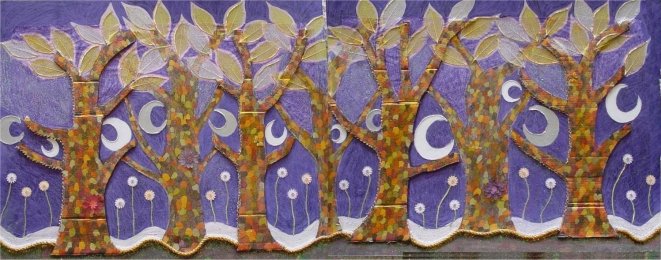
[Above] Bleak Forest (Artwork by Coral Hull, 2007)
"The universe begins to look more like a great thought than a great machine."
-- James Jean, The Mysterious Universe
As the universe dreams us into existence, so do we dream it into existence. The physical manifestation of this dream is creative art. Nature creates and is evolving and transformative. The landscape which is made up of consciousness is nature's canvas and as artists we create onto that same canvas by our actions, but also by our creative intentions. There is a physical consequence to every thought, whether it is occasioned within the body or mind of one's self, since both think. We are creative by the very fact that we are conscious. All beings are creators because they are conscious. Self-consciousness merely allows us to direct our thoughts and intentions.
Albert Einstein the physicist writes of the painter, the poet, the speculative philosopher, and the natural scientist, "... Each make this cosmos and its construction the pivot of [the] emotional life, in order to find in this way peace and security which [one] cannot find in the narrow whirlpool of personal experience". Einstein seems to suggest, we are never more vulnerable, insecure and fearful than in our physical ego state and hence, as creative thinkers, we may appear to draw the universe into our own awareness, in order to re-connect. To Einstein's mind, peace and creative security are not to be found in isolation, but in the larger scheme of things.
In the larger scheme of things we are ourselves universal thinkers, since our consciousness is part of the ongoing creation of the universe. Therefore it would stand to reason that the way in which to gain a real understanding of the universe is through the disintegration of the self-conscious ego state and through an onging expansion of consciousness, where one 'being' becomes, reflects, enhances or creates the other. In this way, true creativity relies on more than internal interpretation and being inward looking for its knowledge. Rather, it is dependant on incoming and outgoing stimulus that redefines and challenges our ideas of physical boundaries and linear time, replacing them with consciousness that is both boundary-less and time-less. This creative flow is the means by which the universe expands and evolves, since the universe is also consciousness.
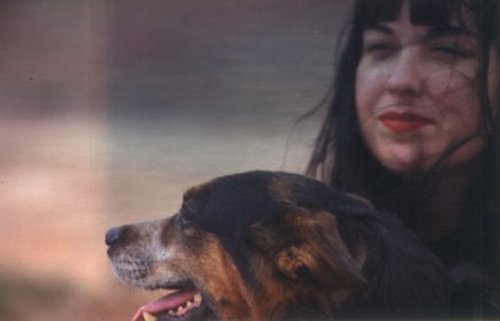
[Above] Binda and Coral, The Breakaways, Coober Pedy, South Australia, Australia. (Photo by Robert Milne, 1998)
THE SOUL OF THE ANIMAL IS THE EYE OF GOD
When the artist or the writer or the creative thinker looks into a landscape, they begin to see their own story. The mirrored landscape reflects the soul of the sentient animal back to itself. All animals (including human beings) are universal beings, since by the very nature of their conscious existence, all are co-creators with the universe. As conscious beings, we create reality through our thinking in a universe where thought is action.
In his book When The Impossible Happens researcher Stanislav Grof describes indigenous Australian people as "spending much time in a remarkable state of consciousness called alcheringa (Dreamtime)". (p210) In a similar fashion, we construct realities that become physically manifest by our 'dreamtime' thinking. All natural physical landscapes are spiritual canvases or creative journals. They are powerhouses of consciousness from a variety of sources; from mountains and forests to rivers and oceans. All are the sacred journeys of spiritual creator beings. To not see the natural world in this way is to seperate ourselves from the creator essence or 'God'.
In the world of the animal the physical becomes spiritual. But the consciousness of the human animal seems to have lost its way and so attempts to control and destroy the fear that is experienced by externalising it. Non-human animals and nature are the primary victims of this projected fear. Fear is a destructive or a non-creative act. Therefore, while one continues to murder and to feast upon the corpses of murdered sentient beings, one will only create the work of self-centredness or a human-centric version of the world. The soul of the animal will be lost to the destroyer, who will be left with the 'limited reality' that is the product of soul destruction. In the consciousness of a universe that is evolving towards love, and to those creative thinkers whose eyes are open to that process, actions and outcomes will be ethical. As artists, our love of beauty naturally wills us to nurture it.
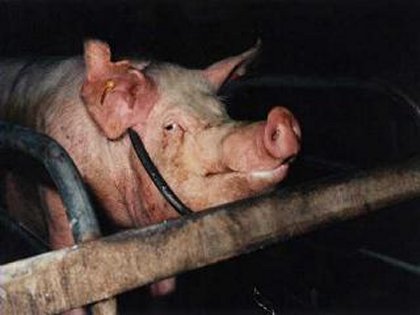
|
"... What a being! What a pig!
What a brute you have swallowed!
As you reflect on the open fire, with
flesh & warmth around your mouth
& your fat poetry book on your lap
used as a plate.
What personality have you devoured tonight?
The great pig is absent from your life,
as you contemplate frozen star clusters
& write of your isolations ..."
(from the poem: 'The Poets and the Pig' by Coral Hull) |
[Above] The eye of a shackled pig. She will never be able to move in the dark shed of an intensive pig farm. (Photo by Patty Mark, 1990s)
The outcry by creative thinkers throughout history over the senseless killing of sentient beings by those "whose God is their belly" has been long and passionate. Theosophist H. P. Blavatsky wrote, "We Europeans are nations of civilized barbarians with but a few millenniums between ourselves and our cave-dwelling forefathers who sucked the blood and marrow from uncooked bones. Thus, it is only natural that those who hold human life so cheaply in their frequent and often iniquitous wars, should entirely disregard the death-agonies of the brute creation, and daily sacrifice millions of innocent, harmless lives." Similarly, but on a far smaller and intimate scale, the novelist Franz Kafka said to several fish, "Now I can look at you in peace; I don't eat you anymore".
As conscious beings who need to interact, we cannot connect creatively or lovingly to that which we destroy. Therefore the more we destroy, the more limited our connection and hence our capacity as a creative observer becomes. In this regard, we will only contribute to the story of our own footsteps, rather than the earth that holds the footprint of many. As the buddhist Mahaparinirvana wrote, "The eating of meat extinguishes the seed of great compassion". Harm to others is self-harm and this extinguishes the seed of profound creativity.
All animals are creative observers who interact with spiritual environments. The eyes of sentient beings reflect the conscious universe back at us in physical form. Once we adopt the soul of the animal and the landscape as our own soul, we will become shape-shifters, capable of perceiving, experiencing and becoming multiple beings, who experience myriad perceptual realities simultaneously. Through our love of each other, we will be imbued with the consciousness of each other. Consciousness runs through the landscape and acts as the information networks of the worlds. Animals know this and by knowing, loving and caring about them, we can know this too. All beings assist our growth as universal channellers and conduits of creative consciousness, as we do theirs.
CHANNELLING AS CREATIVE FORCE
The channeller is the receptive vehicle for myriad consciousness or, as mathematical physicist Roger Penrose describes it "Consciousness: the phenomenon whereby the universe's very existence is made known". (The Emperor's New Mind). As conscious engery in physical form, we all share consciousness with all that is, from star, to animal, to atom. Whether we are aware of it or not, we are receptive to, translators of, and re-creators for a vast network of information that evolves and recycles - all thoughts, all animals, all landscapes. Through our creative thinking we create the universe as we create ourselves. We are the one evolving consciousness that continually recycles and processes knowledge, until perfection is achieved. L-O-V-E is the ultimate outcome and creativity is the learning process whereby we are all evolving each other towards that outcome.
In her book PSIence, Marie D. Jones writes on Edgar Cayce and his idea of universal knowledge: "... Cayce believed that the Akashic Records contained the entire history of every living thing, every memory, event, and emotion, thought, deed and intent that has ever occured in history." She then compares this to Carl Jung's idea of the 'collective unconscious' and goes on to write that, "Rudolph Steiner referred to it as a 'spiritual world' that was as real as the physical and claimed that the ability to perceive this other dimension of existence could allow [us] to 'penetrate the eternal origins of things that vanish with time'". (p89). So, once we remain conscious and hold all within our consciousness, there will no longer be any need for linear time and its endings or beginnings.
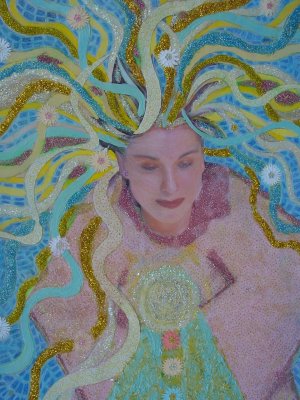
|
The art of the channeller or medium or psychic is to make the unknown known. The channeller brings what at first appears to be the formlessness of the universal night into awareness or beingness, and the expression of this manifests through the creative process. This growth of thought is creativity at its most expansive.
Therefore the role of creative expression is to bring the intangible into tangibility, hence to birth this unknown knowledge into awareness, where it can be acted upon for the benefit of all who encounter and learn from it.
The creative thinker must access a pool of knowledge that is larger than the self and translate knowledge through the self, in order to communicate effectively. In this way the artist becomes a translator of creation, rather than a creator existing in isolation.
Unlike thinking something through, from the vantage point of one's own limited pool of knowledge or experience, channelling involves a broad form of continuous access and creative expression, since the vast pool of consciousness whereby the channeller extracts knowledge is developing and endless. Once the creative thinker moves past the restriction of ego-consciousness, they will be able to access a more universal form of consciousness. |
[Above] The Flower Maker (Artwork by Coral Hull, 2007)
In this state of receptivity there can be no such thing as writer's block. All creative blocks are self imposed rather than universally imposed, since the universe is energetic and flowing. Channelling allows one to become a vehicle or a messenger for the universal consciousness. Through the channel we perceive the voice of the natural world and the thoughts of the universe. The channeller, having absorbed the consciousness of the other, becomes the other, until there is no other, but instead a state of being that incorporates all that is. This allows the channeller or creative thinker to escape the shallow confines of narcissism and to adopt a more universal view as the omnipresent observer, or as one who sings the land into being by becoming it. Our connection to a diverse natural ecosystem is essential in order to access knowledge.
There have been and will continue to be many channellers throughout the history of humankind. These are the mystics, shamans and creative thinkers of a community who access non-ordinary (or non-egotistical) states of consciousness. Recently they are people such as: Jane Roberts and the Seth, Dorothy Maclean and the Findhorn experience, J.Z.Knight and Ramtha, and Ken Carey and The Starseed Transmissions. Channelling has also been adopted by writers, artists and poets throughout history from Michelangelo through to William Blake. Many creative artists accept the fact that they have been humbly and divinely inspired by sources beyond and therefore greater than themselves. Channelling is common occurrance in creative arts, although it appears to have been largely relegated to the fringe of the new age movement. The reason for this may well be that a genuine and ongoing multiplicity of consciousness is in direct opposition to the narcissist, driven by 'ego'.
INNER LANDSCAPES AND THE NATURE OF REALITY
Joseph Campbell said that 'artists are the shamans and myth-makers of our modern world'. Shamans and mystics are capable of navigating both inner and outer realities, that combine to form a larger truth. The self is found only when the developmental journeys become larger than the self. To lose oneself to the whole is to find oneself as the whole. The nature of reality may very well be a shifting interrelating crossover of energy fields possessing consciousness and purpose, where the intent is to evolve into a loving and creative universal force. Perhaps it is the role of the creative artist to ride this wave of knowledge by placing it in a physical context. The creative artist might be said to give the ghost its body, to bring to life in the world that which cannot be named and spoken, to express the sacred and to release the knowledge from its secret chamber, hence making creation a mystical and yet knowable process that is available to all. Like mystics, artists deliver the knowledge to us.
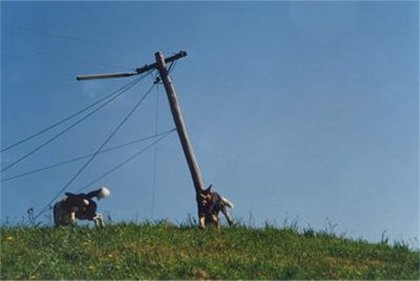
|
"the park is inside my dogs/ [...] they
will fade out over the round cupped edges
of hills into clouds that sink behind
themselves/ [...] my dogs will
be unleashed so that they may contain the
landscapes inside themselves/ in australia
shadows of blue heelers, red kelpies &
photographers ignite along its huge crust
& vanish in an instant/ leaving behind
projected movement & dust-filled film
equipment/ & they may have left a passing
footprint in the sand/ & they may have left
a story for the rock" (from: Landscape Photography With Dogs, Artesian Productions, 2005) |
[Above] Kindi and Binda, Coburg, Melbourne, Victoria, Australia. (Photo by Coral Hull, 1990)
In this way the inner landscape of the creative artist becomes the outer landscape of societal thinking. We are revealed from the inside out or the outside in, as the universal knowledge is accessed and utilised. The artist's role becomes similar to the mystic who receives ecstatic vision of god or, alternatively, the shaman who traverses a multi-dimensional reality. This would suggest accessing both inner recesses of consciousness and the universal consciousness simultaneously. Much of the artwork of Susan Seddon Boulet depicts this journey and many of her works are indicative of the shifting multidimensional nature of consciousness.
In order to achieve such an awareness the creative artist or thinker must abandon this world and make the journey into the self and into the universe, with an awareness that will act as a recorder of the experience. For this reason many artists and writers who are on the journey do not have the time or inclination to focus in order to be able to market or promote themselves, thereby ensuring recognition. Since once the journey into the sublime takes hold, all boundaries become blurred and any notion of self is challenged and transformed by a reality vastly greater than the previously imagined idea of self. During this journey we become the universe and since the universe itself is a creative force, if we are in tune with that force we become active co-creators.
This suggests that the landscape wants us to sing it into being. The dead desire us to hold their spirits within and the animals of this earth speak to us, so that through our intimate awareness of them, and through our creative expression of that knowledge, their voice becomes our own. The idea of inner and outer realities is transcended as all becomes the one multidimensional existence. Creativity is the expression of the journey back to the essential nature of our being. In this regard, it is not bound to either space or time, but to a continuance of evolving consciousness, that permeates a multi-dimensional reality that may traverse three dimensional space and linear time, until they are non-existent or until everything exists simultaneously and eternally.
THE LAND AS CONSCIOUSNESS
Ever since I was a infant I found myself tuning in to another vast and yet myopic world. As a child born with Autism, my reality was not dictated by other human beings, but by the otherness of the world. My 'difference' precluded me from connecting to external realities of human interaction and human society, but very slowly nature won me over, as it naturally wooed me into itself with a gentle and non-invasive consciousness. Even this was difficult as my mind processed a kaleidoscope of colours, cascades of sound and myriad shapes that my eyes wandered away into. I was of nature before I learnt to be human. I bypassed the single ego state and simply learnt to listen to what the natural world was telling me. I wrote my words from a whispered voice that gave dissertation. I became the landscape and entered its consciousness as it entered mine. Creativity became an expressive and expansive journey into a mirrored soul and the many minds of the worlds that continued to reflect my own. Autism left me out of society and in nature. Perhaps art does the same for the creative artist.
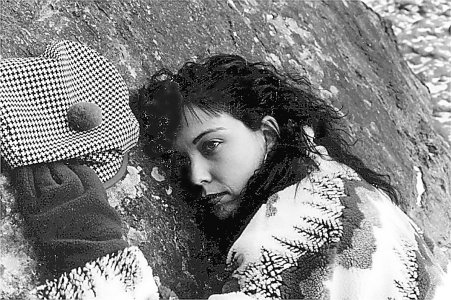
|
"then it is time to leave the earth to freeze,
when the snow goose and the bears leave, so must we,
a heart rate is slowing down in the mountain ranges,
a body temperature lowering itself into peace,
follow the bear that is heavy with rest
and the dull light of the sky into dormancy,
into the time when the scratch marks on the trees
are filled with hoarfrost,
the paths are silent and the sky is flightless, when
the bear's nose is thinking snow." (The North Woods) |
[Above] Coral Hull, Banff National Park, Alberta, Canada. (Photo by Robert Hilles, 1998)
I think it is important that we, as creative thinkers, conduct detailed research into our areas of interest. This allows us to tap into the thinking of the society. Since we are appealing to a wider general audience, we need to know the habits of the great snowy owl, or the way that the hoarfrost settles upon the needles of the fir and in what temperature this occurs and why it occurs, because, as the great Canadian writer John Muir wrote, "When we try to pick out anything by itself, we find it hitched to everything else in the universe". As a writer/ poet, I tend to combine a sense of the naturally mystical elements of nature and the psyche, with researched facts.
But, beyond formal investigation, there comes a point where as a channeller or interpreter, I place my face upon the moss covered stone and I listen to what the land is saying about the oncoming winter, about the wading moose, the composition of snow, the icy blue lakes and the hibernation of the bears. Although simple facts can be used as the launching pad into the world, this 'other vision, invokes physical and spiritual connection beyond the three dimensional physical world and yet involving it at the same time. Needless to say, the deterioration of self consciousness into nature's stone is the beginning of a universal reality that expands the consciousness and creates the stories of the worlds. Indigenous peoples in their most spiritual state and when imbued with nature are doing this very same thing. They are listening in. They are creating the landscape as it creates them.
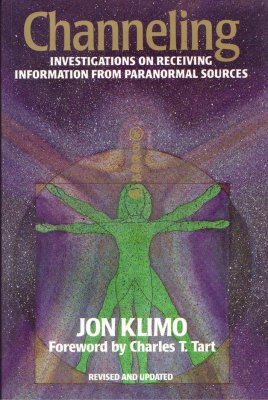
|
The accessing of other dimensions via consciousness leads us to explore potential realities, through our ongoing observation and occupation of external and internal worlds, many of which remain unknown, but with each relying on the existence or truth of the other in order to exist. The creative thinker is able to shift their consciousness and thereby access hidden realities that are not accessible under the influence of the single ego state that society has come to depend upon. Often this process has been brought about through the use of drugs, or more naturally via channelling.
There is a theory of thought both in the parapsychological field and in quantum physics that suggests that our physical surroundings react in direct correlation to what we are thinking.
The evidence of this interaction goes back to the creation of curses and magical entities by many older cultures to the thought form "Philip" who was created in a parapsychological experiment in Canada.
Creating our own reality, is suddenly given new meaning. Since creative art is the product of thought, in creating art, we are in fact creating reality. As the channellers of creative cosmic consciousness, we become vehicles of limitless energy and creation. When nothing is certain anything is possible. |
[Above] Channeling by Jon Klimo (Cover Art by North Atlantic Books, 1998)
The mind of the creative artist communicates through matter the moment we have the intention to create. Our creative ideas move forth into the world made physical, through the unending evolving consciousness of the universe. Our thoughts recreate reality in the same way that our art creates reality. This created reality then feeds back into ourselves to be re-experienced, redefined and reprocessed in an endlessly developing mobius strip of conscious interaction between us. The land creates us with its consciousness, in the same way that we create it with our consciousness, imbuing it with sacredness that follows energy lines, sites and portals to multi-dimensionality. These portals can be accessed by shamans, mystics, elders, merlins and magicians. But when they are accessed by artists, then the story will be brought back to the society through physical translation.
The role of the creative artist must be one of universal ethics and swift reconnection with land-spirit, rather than one violence and fear-based delusion. To follow the ego back into a society in crisis, is detrimental to the creative process. For example, when caught up in the mindset of mindlessly massacring thousands of canetoads, Darwin locals reaffirm their disconnection to the land, by their temporary and imagined dominion over the natural world. Meanwhile, the canetoads who were introduced by human beings, continue to migrate across Australia's Top End more effectively than Europeans and with less harm to the environment. Rather than dying out as predicted, local wildlife slowly adapts to the entry of new species at its own pace, rendering the violent genocide ineffective and pointless. The killing of one introduced species by another invader is projected fear.
Genocide takes one's own consciousness away from the essential nature of being, since the preoccupation with murder is fear-based in a universe that is evolving towards love. To murder any sentient being on this scale is a form of de-evolution that can be likened to the backward evolving consciousness of the common sociopath, because the act itself is sociopathic. So those who believe they can allow or disallow what being is to enter the consciousness of the landscape are living in delusion. To them, it is fear that dictates what is and what isn't possible, rather than an expanding consciousness that is only made possible through compassion for all that is. We must have empathy and sustained and ongoing loving connection to the other in order to evolve creatively.
A MULTIPLICITY OF CONSCIOUSNESS
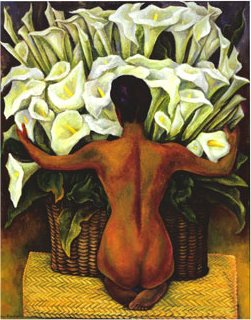
|
Some poets believe that they write to and for that greater 'beingness', which exists outside themselves, perhaps until they become that 'beingness' and are again whole. The poet and the muse are the one continual evolving soul with each accessing and assisting the other to grow.
Channelling would also suggest a certain multiplicity of consciousness where the "channel" becomes a vehicle, through which other parts or forms of normally hidden consciousness are expressed.
The concept of a writer, poet, artist, sculptor, musician or other creative thinker, channelling, or allowing themselves to be touched by the voice of the muse, might be compared to a kind of creative mediumship, where one aspect of the mind seeks to relay and represent the aspect of 'the other' via creative expression.
Throughout history, both creative artists, spiritual mediums and psychics have acted as channels for both internal and external consciousness, leading one to theorise that 'all is consciousness or energy' with the physicality of the brain and body merely acting as temporary conduits for our thoughts. |
[Above] Nude With Calla Lilies (Artwork by Diego Rivera, 1944)
One of the most expansive and complex states of consciousness is that of the multiple or multiple personality, who, put more accurately, has a central psychic space that harbours a system of alternating streams of consciousness or ego states. Most sentient beings would appear to be multidimensional beings, which means their psyche is layered and holographic. However they would still operate in a single ego state, that is, the one being occupying the one physical body. This is in stark contrast to a multiple, whose psyche becomes the vehicle through which a variety of selves exist, with each of these selves having their own sense of autonomy, personal history, strengths and weaknesses, self-awareness and life purpose. A multiple operates best when the system is co-operative or co-conscious. When the system is non-cooperative or there are amnesic barriers between the selves due to trauma, then we have what is commonly refered to as MPD (Multiple Personality Disorder).
Yet, in its most functional and expansive state, multiplicity is an extension of consciousness beyond all known and therefore currently acceptable ideas of consciousness where one or many might occupy the physical body, or indeed, space and time. Within the body of a multiple, we can have male and female selves, babies and infants, animal selves, angelic beings and archetypal selves, otherkin such as dryads, faeries and extra terrestrial consciousness. Some may be walk-ins and others may be simply like the person next door. Some selves may be simple or fragmentary and others might be layered and complex. The central psyche of a multiple system becomes a meeting place where selves are channelled, are interactive, brought forth, braided, partially integrated or exist separately and autonomously. The central psyche of a multiple system of selves is imbued with ongoing, evolving and naturally shifting streams of alternating consciousness. Multiples are channellers.
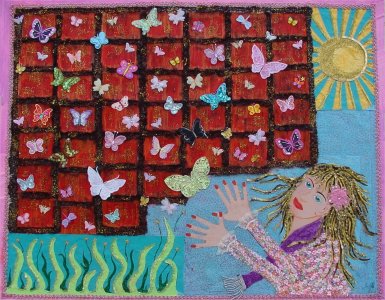
|
In our natural and holistic state as creative artists and thinkers, we act as vehicles for others to speak through. We regularly become inspired by voices and thoughts greater than our own.
We lift the pen or the brush by the instruction of the universe. We are not closed off or existing in isolation. We are open to receiving information and, once we became skilled at this, the information that we receive becomes limitless. Everything will begin to speak through us, as we speak through it, and hence, as creative thinkers and artists, we will become the co-creators of a greater universal reality through consciousness. |
[Above] The Butterfly Wall (Artwork by Coral Hull, 2007)
While wisdom is necessary for physical survival, fear and hatred hinders spiritual growth. While we remain ego-based we are fear-based, since we become protective of a single state of being, or one that is isolated from the flowing evolving creative force of the universe. This is entrapment born of the desire to control or possess. It is far more beneficial to human beings, as a creative evolving conscious force, that is expressed to through creative art, to step into line with 'God' the universe of evolving love. All one has to do is work with and for the universe and not against it, to live a miraculous and inspired life. While this means a reprogramming of one's consciousness out of mass societal consciousness, the good news is that universe is open to all beings 24/7.
THE MIRRORED SOUL: THAT WHICH WE LOVE
Art and ethics can only be anathema to one another when a society has lost its moral conscience and its spiritual connection to a universal consciousness. As Ken Wilber writes, "Because the universe has direction, we ourselves have direction. There is meaning in the movement, intrinsic value in the embrace." Similarly does Ralph Waldo Emerson write, "We lie in the lap of immense intelligence, which by any other name is Spirit. [...] We -- and all beings as such -- are drenched in this meaning, afloat in a current of care and profound value, ultimate significance, intrinsic awareness. We are part and parcel of this immense intelligence, this Spirit-in-action, this God-in-the-making ... " As sentient beings, we are a pond that reflects the surface of the soul of the world. As creative practitioners, we reflect this process by the product of our creations. The landscape, and the sentient beings that inhabit it, must become our sacred mind. All must be our religion, our place of worship, our commune, our sanctuary and our art. Our true potential can only be achieved by shifting our consciousness from one of ego to one of multidimensionality and compassion. Love cannot exist while we continue to destroy nature and to torture, maim and feast on the corpses of murdered sentient beings. The slaughterhouse of the gut must be transformed into the temple of the heart, if we are to evolve both consciously and creatively.
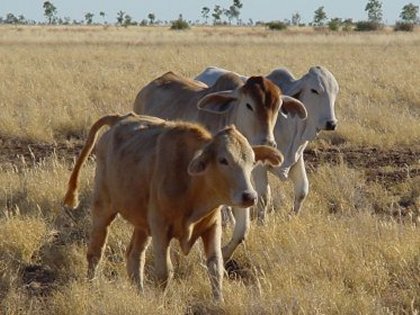
|
Creativity relies on a physical connection to the subject, so that the observer becomes the observed. We cannot connect with that which we destroy. Hence, when we destroy, we cannot create. As writer George Bernard Shaw wrote: "We pray on Sundays that we may have light/ To guide our footsteps on the path we tread;/ We are sick of war, we don't want to fight,/ And yet we gorge ourselves upon the dead". To be non-caring to the suffering of the other, is to lack both spiritual and creative insight. As Helen Keller wrote, "The best and most beautiful things in the world cannot be seen or even touched. They must be felt within the heart." |
[Above] Young Cows, Barkly Hwy, Queensland, Australia. (Photo by Coral Hull, 2002)
Throughout history, both creative thinkers and spiritual thinkers have shared this same vision of world peace for all beings, from Thomas Edison who wrote: "Non-violence leads to the highest ethics, which is the goal of all evolution. Until we stop harming all other living beings, we are still savages", to the Buddha who taught; "To become vegetarian is to step into the stream which leads to nirvana". Since consciousness affects matter and other consciousness around it, our thinking creates our reality both in the spiritual and the physical world, until both worlds are intersecting, interlocking and existing simultaneously. Both are the one living, breathing, thinking universal consciousness expressed in different forms. Loving creativity is the way to universal truth.
Therefore it would stand to reason that the less harm that I inflict upon other sentient beings, the more I am able to hold their peace and beauty within my own soul. The more I am able to act as a living conduit for the benevolent universal consciousness, the more I become not only a creator, but a co-creator who contributes to the conscious being that is the universe. The universe is evolving towards love. Any sentient being who is not allowing themselves to become a part of this continuous process will suffer as a result. Where l-o-v-e exists, suffering ceases to exist, since once we become benevolent, the benevolent universal consciousness reflects and creates alongside us, working towards our best interests. And our best intentions are in the interests of all.
Author Roger Penrose writes, "The universe is made of stories, not atoms". The landscape is consciousness and the sentient beings of consciousness are the mirrored soul of our being, or that which we love. Creative artists and creative thinkers can assist in this process by embracing and holding external realities within. In this way, all knowledge becomes accessible, all time eternal and the ongoing universal expansion of creativity possible.
Sources and References:
Albert Einstein, address to the Physical Society, 1918. Eureka moments I - creative people on creativity - special issue: The Science of Creativity. Discover. (http://discovermagazine.com/) 1996
Stanislav Grof, When The Impossible Happens: Adventures In Non-Ordinary Realities. Sounds True. 2006
Coral Hull, How Do Detectives Make Love?. Artesian Productions. 2005
Have Animals Souls? Article by H. P. Blavatsky http://www.blavatsky.net/blavatsky/arts/HaveAnimalsSouls.htm
Vegetarianism and Spirituality - from ancient times to the present, The Samara Foundation. (http://www.samarafoundation.com/vegetarian.htm)
Vegetarian Quotes (http://www.indianchild.com/vegeterianism_quotes.htm)
Roger Penrose, The Emperor's New Mind: Concerning Computers, Minds and The Laws of Physics. Oxford University Press. 1989
Marie D. Jones, PRSience. New Page Books. 2007
Jane Roberts and Seth,The Way Toward Health. Amber-Allen Publishing. 1997
The Ramtha Interviews, What The Bleep Do We Know, DVD. (http://www.whatthebleep.com/). 2006
Ken Carey, The Starseed Transmissions. HarperSanFrancisco. 1991
Joseph Campbell, The Power of Myth. (http://en.wikipedia.org/wiki/The_Power_of_Myth). 1988
Coral Hull, The North Woods. Artesian Productions. 2005
John Muir, My First Summer in the Sierra. Boston: Houghton Mifflin. 1911
The Philip Experiement, (http://www.thebrgs.homestead.com/philipexperiment.html). Toronto. 1970s
Charity Focus.Org. Daily Good. Ken Wilbur Quote. April. (http://www.dailygood.org//). 2007
Ralph Waldo Emeron, ESSAY II Self-Reliance from: Essays: First Series. (http://www.emersoncentral.com/essays1.htm). 1841
Quote by Helen Keller, US blind & deaf educator (1880 - 1968). The Quotations Page. (http://www.quotationspage.com/quote/30187.html)
Jon Klimo, Channeling. North Atlantic Books. 1998.
Susan Seddon Boulet, Shaman: The Paintings of Susan Seddon Boulet. Pomegranate Art Books. 1989
About the Writer Coral Hull
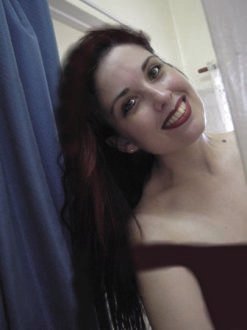
|
Coral is the author of over 50 books of poetry, prose poetry, fiction, artwork and digital photography. Born with Autism in 1965, she was raised under disadvantaged circumstances in the working class suburb of Liverpool in Sydney's outer west. Coral became concerned with issues of social justice and spirituality from an early age. Coral became an ethical vegan and an animal rights advocate who has since spent much of her life working voluntarily on behalf of animals and the environment, both as an individual and for various non-profit organisations. She is also the Executive Editor and Publisher of Thylazine: an electronic journal featuring articles, interviews and reviews of the recent work of Australian writers and artists. Coral Hull's complete works are now available from Artesian Productions (Darwin, Australia). Coral holds a Doctor of Creative Arts Degree (Creative Writing Major) from the University of Wollongong. An extensive biography, list of publications, festivals, interviews, articles and reviews are online. Coral is The Director of The Thylazine Foundation: Arts, Ethics and Literature. Coral Hull's work is in the public domain for non-commercial use under the Creative Commons License. |
[Above] Photo of Coral Hull, Elliot Hotel, Elliot, Northern Territory, Australia, 2001.
I Next I
Back I
Exit I
Thylazine No.12 (June, 2007) |



